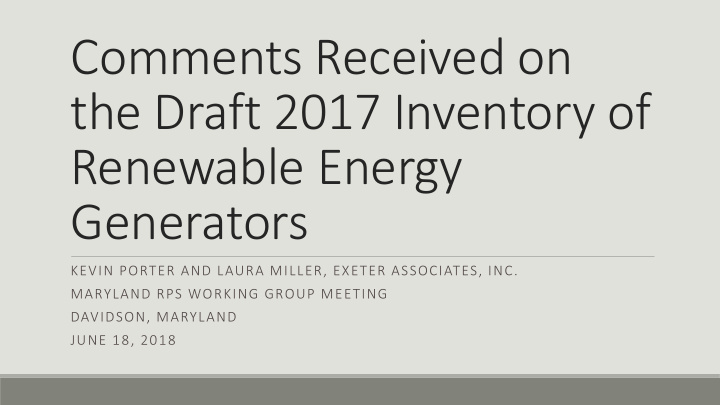



Comments Received on the Draft 2017 Inventory of Renewable Energy Generators KEVIN PORTER AND LAURA MILLER, EXETER ASSOCIATES, INC. MARYLAND RPS WORKING GROUP MEETING DAVIDSON, MARYLAND JUNE 18, 2018
Purpose and Preliminary Findings of Draft Renewable Energy Inventory Purpose of report is to estimate the quantity of proposed, planned and operating generation resources that are eligible for the Maryland, and to assess how much, if any, generation capacity would need to be developed to meet the requirements of the Maryland RPS and other state RPS policies. Draft report finds a current and projected shortfall of non-solar carve-out Tier 1 RECs in PJM, but adequate supplies of solar RECs and Tier 2 RECs. 2
Report Methodology Reviewed potential to satisfy Maryland’s RPS requirements from 2018 through 2030 as the Maryland RPS requirements are held constant after the year 2020. Analyzed current RPS requirements in PJM, encompassing eight PJM states and DC with mandatory RPS requirements, as well as two PJM states with voluntary RPS targets. Aligned PJM states’ RPS resources to match with Maryland’s Tiers to evaluate competition for resources. Applicable generation was limited to resources categorized as Maryland-certified in PJM Generator Attributes Tracking System (GATS). Considered number of projects in the PJM Interconnection Queue against historical estimated in- service rates by individual technology between 2012 and 2014. Reviewed the capacity and number of certified renewable energy generating facilities located within PJM’s footprint only. (While this report only considered facilities within PJM to satisfy the RPS requirements, generation outside of PJM may be used to fulfill non-carve-out Tier 1 requirements, such as wind facilities in the Midwest or hydro facilities in New York.) 3
Comments Comments received from PJM and MDV-SEIA. Comments are expected from AWEA and Brookfield Renewables. Report’s basic finding that there is a shortage of Tier 1 non -solar carve-out RECs currently within PJM was questioned: ◦ All states are meeting their RPS targets. ◦ Tier 1 REC prices within PJM are low. Recommendations to adjust report’s methodology in several respects. 4
Eligibility for Maryland RPS Report counted generation registered with the Maryland Public Service Commission for the Maryland RPS. In fact, there are several renewable energy projects for the Maryland RPS that are not registered in Maryland. Urged to take a PJM-wide perspective in estimating demand and supply for RPS policies within PJM and not limit analysis only to generators registered for the Maryland RPS. 5
Solar Solar assumed only to be used for the solar carve-out in the Maryland RPS, and for solar carve- outs in states within PJM. However, there’s more solar generation than can be accommodated by solar carve -out policies, and it was suggested to include this “excess” solar as part of Tier 1. 6
Projecting Additional Renewable Energy Capacity Mostly relied on PJM Interconnection Queue to project the addition of renewable energy capacity. Not all projects in the PJM Interconnection Queue successfully come on-line. Derived a weighted average of the percentage of projects in the PJM Interconnection Queue that came on-line, by technology, between 2012 and 2014. Some technologies had only a fraction of capacity come on-line in those years as compared to total capacity in the queue, such as wind (3 percent). Comments that the projected capacity by technology in the Inventory did not comport with how much capacity was being developed. Suggested the methodology be revisited and revised. 7
Other Comments Review historic and projected capacity factors for wind and solar. Consider not including states with voluntary RPS targets. Correct some data errors for generation and load in various states. 8
Thank you for your comments! The Inventory is now being revised. A new version of the report will be made available by July 31 st , 2018. 9
Recommend
More recommend